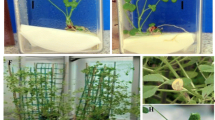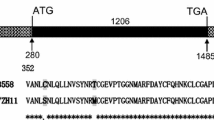Abstract
Key message
This is the first report that GLP gene (OsGLP2-1) is involved in panicle blast and bacterial blight resistance in rice. In addition to its resistance to blast and bacterial blight, OsGLP2-1 has also been reported to co-localize with a QTLs for sheath blight resistance in rice. These suggest that the disease resistance provided by OsGLP2-1 is quantitative and broad spectrum. Its good resistance to these major diseases in rice makes it to be a promising target in rice breeding.
Abstract
Rice (Oryza sativa) blast caused by Magnaporthe oryzae and bacterial blight caused by Xanthomonas oryzae pv. oryzae are the two most destructive rice diseases worldwide. Germin-like protein (GLP) gene family is one of the important defense gene families which have been reported to be involved in disease resistance in plants. Although GLP proteins have been demonstrated to positively regulate leaf blast resistance in rice, their involvement in resistance to panicle blast and bacterial blight, has not been reported. In this study, we reported that one of the rice GLP genes, OsGLP2-1, was significantly induced by blast fungus. Overexpression of OsGLP2-1 quantitatively enhanced resistance to leaf blast, panicle blast and bacterial blight. The temporal and spatial expression analysis revealed that OsGLP2-1is highly expressed in leaves and panicles and sub-localized in the cell wall. Compared with empty vector transformed (control) plants, the OsGLP2-1 overexpressing plants exhibited higher levels of H2O2 both before and after pathogen inoculation. Moreover, OsGLP2-1 was significantly induced by jasmonic acid (JA). Overexpression of OsGLP2-1 induced three well-characterized defense-related genes which are associated in JA-dependent pathway after pathogen infection. Higher endogenous level of JA was also identified in OsGLP2-1 overexpressing plants than in control plants both before and after pathogen inoculation. Together, these results suggest that OsGLP2-1 functions as a positive regulator to modulate disease resistance. Its good quantitative resistance to the two major diseases in rice makes it to be a promising target in rice breeding.








Similar content being viewed by others
References
Ballini E, Morel JB, Droc G, Price A, Courtois B, Notteghem JL, Tharreau D (2008) A genome-wide meta-analysis of rice blast resistance genes and quantitative trait loci provides new insights into partial and complete resistance. Mol Plant Microbe Interact 21:859–868
Banerjee J, Maiti MK (2010) Functional role of rice germin-like protein1 in regulation of plant height and disease resistance. Biochem Biophys Res Commun 394:178–183
Bari R, Jones JD (2009) Role of plant hormones in plant defense responses. Plant Mol Biol 69:473–488
Brown RL, Kazan K, McGrath KC, Maclean DJ, Manners JM (2003) A role for the GCC-box in jasmonate-mediated activation of the PDF1.2 gene of Arabidopsis. Plant Physiol 132:1020–1032
Carrillo MGC, Goodwin PH, Leach JE, Leung H, Vera Cruz CM (2009) Phylogenomic relationships of rice oxalate oxidases to the cupin superfamily and their association with disease resistance QTL. Rice 1:67–69
Christensen AB, Thordal-Christensen H, Zimmermann G, Gjetting T, Lyngkjaer MF, Dudler R, Schweizer P (2004) The germinlike protein GLP4 exhibits superoxide dismutase activity and is an important component of quantitative resistance in wheat and barley. Mol Plant Microbe Interact 17:109–117
Davidson RM, Manosalva PM, Snelling J, Bruce M, Leung H, Leach J (2009) Rice germin-like proteins: allelic diversity and relationships to early stress responses. Rice 3:43–55
Deng H, Liu H, Li X, Xiao J, Wang S (2012) A CCCH-type zinc finger nucleic acid-binding protein quantitatively confers resistance against rice bacterial blight disease. Plant Physiol 158:876–889
Fu D, Uauy C, Distelfeld A, Blechl A, Epstein L, Chen X, Sela H, Fahima T, Dubcovsky J (2009) A kinase-START gene confers temperature-dependent resistance to wheat stripe rust. Science 323:1357–1360
Fu J, Liu H, Li Y, Yu H, Li X, Xiao J, Wang S (2011) Manipulating broad-spectrum disease resistance by suppressing pathogen-induced auxin accumulation in rice. Plant Physiol 155:589–602
Fukuoka S, Saka N, Koga H, Ono K, Shimizu T, Ebana K, Hayashi N, Takahashi A, Hirochika H, Okuno K, Yano M (2009) Loss of function of a proline-containing protein confers durable disease resistance in rice. Science 325:998–1001
Godfrey D, Able A, Dry I (2007) Induction of a grapevine germin-like protein (VvGLP3) gene is closely linked to the site of Erysiphe necator infection: a possible role in defense? Mol Plant Microbe Interact 20:1112–1125
Hayashi N, Inoue H, Kato T, Funao T, Shirota M, Shimizu T, Kanamori H, Yamane H, Hayano-Saito Y, Matsumoto T, Yano M, Takatsuji H (2010) Durable panicle blast-resistance gene Pb1 encodes an atypical CC-NBS-LRR protein and was generated by acquiring a promoter through local genome duplication. Plant J 64:498–510
Himmelbach A, Liu L, Zierol U, Altschmied L, Maucher H, Beier F, Muller D, Hensel G, Heise A, Schutzendubel A, Kumlehn J, Schweizer P (2010) Promoters of the barley germin-like GER4 gene cluster enable strong transgene expression in response to pathogen attack. Plant Cell 22:937–952
Hu K, Qiu D, Shen X, Li X, Wang S (2008) Isolation and manipulation of quantitative trait loci for disease resistance in rice using a candidate gene approach. Mol Plant 1:786–793
Jia Y, Liu G, Costanzo S, Lee S, Dai Y (2009) Current progress on genetic interactions of rice with rice blast and sheath blight fungi. Front Agric China 3:231–239
Kauffman HE, Reddy APK, Hsieh SPY, Merca SD (1973) An improved technique for evaluating resistance of rice varieties to Xanthomonas oryzae. Plant Dis Rep 57:537–541
Kim DS, Hwang BK (2014) An important role of the pepper phenylalanine ammonia-lyase gene (PAL1) in salicylic acid-dependent signalling of the defence response to microbial pathogens. J Exp Bot 65:2295–2306
Knecht K, Seyffarth M, Desel C, Thurau T, Sherameti I, Lou B, Oelmüller R, Cai D (2010) Expression of BvGLP-1 encoding a germin-like protein from sugar beet in Arabidopsis thaliana leads to resistance against phytopathogenic fungi. Mol Plant Microbe Interact 23:446–457
Kou Y, Wang S (2010) Broad-spectrum and durability: understanding of quantitative disease resistance. Curr Opin Plant Biol 13:181–185
Laloi C, Apel K, Danon A (2004) Reactive oxygen signalling: the latest news. Curr Opin Plant Biol 7:323–328
Lane B (1994) Oxalate, germin, and the extracellular matrix of higher plants. FASEB J 5:294–301
Lane B (2002) Oxalate, germins, and higher-plant pathogens. IUBMB Life 53:67–75
Li ZK, Arif M, Zhong DB, Fu BY, Xu JL, Domingo-Rey J, Ali J, Vijauakumar CHM, Yu SB, Khush GS (2006) Complex genetic networks underlying the defensive system of rice (Oryza sativa L.) to Xanthomonas oryzae pv. oryzae. Proc Natl Acad Sci USA 103:7994–7999
Liu B, Zhang S, Zhu X, Yang Q, Wu S, Mei M, Mauleon R, Leach J, Mew T, Leung H (2004) Candidate defense genes as predictors of quantitative blast resistance in rice. Mol Plant Microbe Interact 17:1146–1152
Liu W, Liu J, Triplett L, Leach J, Wang G (2014) Novel insights into rice innate immunity against bacterial and fungal pathogens. Annu Rev Phytopathol 52:213–241
Liu Q, Yang J, Zhang S, Zhao J, Feng A, Yang T, Wang X, Mao X, Dong J, Zhu X, Leung H, Leach JE, Liu B (2016) OsGF14b positively regulates panicle blast resistance, but negatively regulates leaf blast resistance in rice. Mol Plant Microbe Interact 29:46–56
Lou Y, Baldwin I (2006) Silencing of a germin-like gene in Nicotiana attenuata improves performance of native herbivores. Plant Physiol 140:1126–1136
Manosalva P, Davidson R, Liu B, Zhu X, Hulbert S, Leung H, Leach J (2009) A Germin-Like protein gene family functions as a complex QTL conferring broad-Spectrum disease resistance in rice. Plant Physiol 149:286–296
Manosalva P, Bruce M, Leach J (2011) Rice 14-3-3 protein (GF14e) negatively affects cell death and disease resistance. Plant J 68:777–787
McDonald BA, Linde C (2002) Pathogen population genetics, evolutionary potential, and durable resistance. Annu Rev Phytopathol 40:349–379
Mei C, Qi M, Sheng G, Yang Y (2006) Inducible overexpression of a rice allene oxide synthase gene increases the endogenous jasmonic acid level, PR gene expression, and host resistance to fungal infection. Mol Plant Microbe Interact 19:1127–1137
Olson P, Varner J (1993) Hydrogen peroxide and lignifications. Plant J 4:887–892
Pan X, Welti R, Wang X (2010) Quantitative analysis of major plant hormones in crude plant extracts by high-performance liquid chromatography-mass spectrometry. Nat Protoc 5:986–992
Ramalingam J, Vera Cruz CM, Kukreja K, Chittoor JM, Wu JL, Lee SW, Baraoidan M, George ML, Cohen MB, Hulbert SH, Leach J, Leung H (2003) Candidate defense genes from rice, barley, and maize and their association with qualitative and quantitative resistance in rice. Mol Plant Microbe Interact 16:14–24
Roumen EC (1994) In: A strategy for accumulating genes for partial resistance to blast disease in rice within a conventional breeding program. In: Zeigler RS, Leong SA, Teng PS (eds) Rice Blast Disease. CAB International, Cambridge, pp 245–265
Roychowdhury M, Jia Y, Jia MH, Fjellstrom R, Cartwright RD (2012) Identification of the rice blast resistance gene Pib in the National Small Grains Collection. Phytopathology 102:700–706
Shaner NC, Campbell RE, Steinbach PA, Giepmans BN, Palmer AE, Tsien RY (2004) Improved monomeric red, orange and yellow fluorescent proteins derived from Discosoma sp. red fluorescent protein. Nature Biotechnol 22:1567–1572
Toki S, Hara N, Ono K, Onodera H, Tagiri A, Oka S, Tanaka H (2006) Early infection of scutellum tissue with Agrobacterium allows high-speed transformation of rice. Plant J 47:969–976
Wei Y, Zhang Z, Andersen C, Schmelzer E, Gregersen P, Collinge D, Smedegaard-Petersen V, Thordal-Christensen H (1998) An epidermis/papilla-specific oxalate oxidase-like protein in the defense response of barley attacked by the powdery mildew fungus. Plant Mol Biol 36:101–112
Wu JL, Sinha PK, Variar M, Zheng KL, Leach J, Courtois B, Leung H (2004) Association between molecular markers and blast resistance in an advanced backcross population of rice. Theor Appl Genet 108:1024–1032
Zhou F, Zhang Z, Gregersen PL, Mikkelsen JD, de Neergaard E, Collinge DB, Thordal-Christensen H (1998) Molecular characterization of the oxalate oxidase involved in the response of barley to the powdery mildew fungus. Plant Physiol 117:33–41
Zhuang JY, Ma WB, Wu JL, Chai RY, Lu J, Fan YY, Jin MZ, Leung H, Zheng KL (2002) Mapping of leaf and neck blast resistance genes with resistance gene analog, RAPD and RFLP in rice. Euphytica 128:363–370
Zimmermann G, Bäumlein H, Mock HP, Himmelbach A, Schweizer P (2006) The multigene family encoding germin-like proteins of barley. Regulation and function in basal host resistance. Plant Physiol 142:181–192
Acknowledgments
This research was supported partially by National Natural Science Foundation of China (NSFC)-International Rice Research Institute (IRRI) project (31461143019), the 973 project of Ministry of Science and Technology, China (2006BFD33320), the National Natural Science Foundation of China (30771392), the Presidential Foundation of the Guangdong Academy of Agricultural Sciences, China (201201), the Earmarked Fund for Modern Agro-Industry Technology Research System (CARS-01-24). We thank professor Jan Leach in Colorado State University, USA and Dr Hei Leung in International Rice Research Institute for their valuable discussion and suggestions on this study and during manuscript preparation. We also thank Jia Jian for technical support of sub-localization. We are grateful to Zhang Weina (Center for Agrobiological Gene Research, Guangdong Academy of Agricultural Sciences) for help with laser confocal microscopy.
Author contributions
QL conducted the quantitative qRT-PCR assay, transgenic functional confirmation and chemical treatment experiments, drafting the manuscript and proposal writing. JY and WJ evaluated the blast and Xoo resistance of the control and transgenic plants. SY conducted the quantitative analysis of the endogenous JA. SZ, JZ, TY, XW, XM, and JD participated in RNA extraction and quantitative qRT-PCR assays. XZ and BL conceived of the study, drafted proposal and corrected manuscript.
Author information
Authors and Affiliations
Corresponding authors
Ethics declarations
Conflict of interest
The authors declare no conflict of interest.
Additional information
Bin Liu is the first corresponding author.
Electronic supplementary material
Below is the link to the electronic supplementary material.
Rights and permissions
About this article
Cite this article
Liu, Q., Yang, J., Yan, S. et al. The germin-like protein OsGLP2-1 enhances resistance to fungal blast and bacterial blight in rice. Plant Mol Biol 92, 411–423 (2016). https://doi.org/10.1007/s11103-016-0521-4
Received:
Accepted:
Published:
Issue Date:
DOI: https://doi.org/10.1007/s11103-016-0521-4




